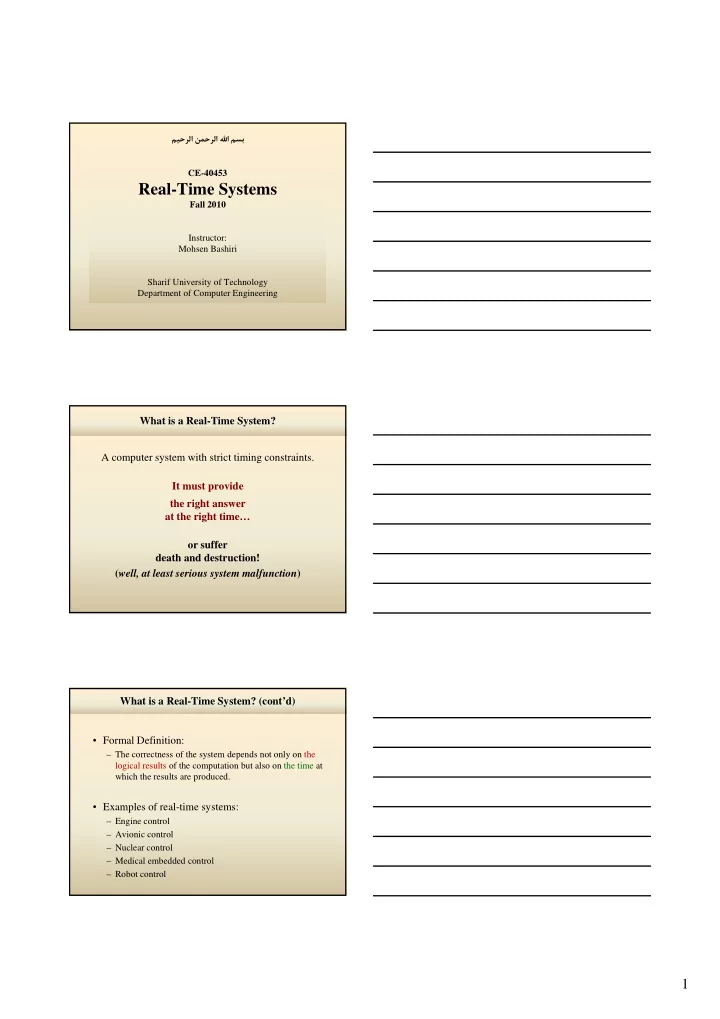

ﻢﻴﺣﺮﻟا ﻦﻤﺣﺮﻟا ﷲا ﻢﺴﺑ CE-40453 Real-Time Systems Fall 2010 Instructor: Mohsen Bashiri Sharif University of Technology Department of Computer Engineering What is a Real-Time System? A computer system with strict timing constraints. It must provide the right answer g at the right time… or suffer death and destruction! ( well, at least serious system malfunction ) What is a Real-Time System? (cont’d) • Formal Definition: – The correctness of the system depends not only on the logical results of the computation but also on the time at which the results are produced. • Examples of real-time systems: – Engine control – Avionic control – Nuclear control – Medical embedded control – Robot control 1
Real-Time System Example Pacemaker Senses heart rate breathing blood temp Generates electrical pulse(s) User Interface, Communication, Monitor Battery Control Law software Plant sensor motor controlled device Misconceptions About Real-Time Computing • Real-time systems = “fast” systems. – Advances in supercomputer hardware will take care of real-time requirements. – Real-time systems research = performance engineering. • There is no science in real-time systems design. – There are universal, widely accepted methodologies for specification and design. – The study of real-time systems = scheduling theory. – Real-time programming is assembly coding, priority interrupt programming, and device driver writing. 2
Misconceptions About Real-Time Computing (cont’d) • Guaranteeing the real-time performance is not possible because: – Hardware failure – Software bus • Real time systems function in a static environment. R l i f i i i i • You will never need to build a real-time OS. Real-Time Challenges!!! • Specification and verification. • Scheduling theory. • Real-time operating systems. • Real-time programming languages and design methodology. gy • Distributed real-time database. • Artificial intelligence. • Fault tolerance. – Performability • Real-time system architecture. • Real time communication. Computer Science: The Art of Compromise ( or Abstraction) Accuracy $$ Space Time From design to implementation, what is more important? 3
The Real-Time Blanket “Real-Time” is an added constraint placed on top of every component of a system p p y p y from the hardware to the application. Overall Class Objective Good high-level understanding of real-time systems. What are the critical issues during design implementation and testing? design, implementation, and testing? – Low-level hardware control – Concurrent programming – Real-time scheduling – System modeling – Worst-Case Execution Time analysis (WCET) What we will see in this course? – Real-time system characterization, components and modeling – Real-Time Scheduling Pacemaker • Uni-processor scheduling Senses • Multiprocessor scheduling heart rate breathing g • Schedulability analysis y y blood temp – Resource management Generates – Measurement of: electrical pulse(s) • Reliability User Interface, • Performance and Performability Communication, • Power consumption Monitor Battery – Real-time communication 4
More specifically …. General concepts hard or soft real-time, periodic tasks, sporadic tasks, jobs, release times, deadlines, real-time systems components, … Characterization Scheduling theory, time and timing constraints (system of real ‐ time modeling using timed automata), tasks precedence systems constraints and dependencies, embedded systems, multiprocessor and distributed systems. Scheduling polling, round-robin, preemptive, nonpreemptive, table- driven, priority-driven, Rate-Monotonic (RM), Deadline- d i i it d i R t M t i (RM) D dli Monotonic (DM), Earliest-Deadline First (EDF), … Resource Motivations, resource access control, resource sharing management under EDF, resource management and reclaiming. Timing analysis Schedulability tests, worst-case execution time (WCET), static analysis, dynamic analysis, … Reliability, performance, performability, and power/energy System measuring consumption. Timing constraints in real ‐ time communication, real ‐ time Real-time communication protocols, x ‐ by ‐ wire. communication Real-Time Systems Prerequisites. – Basic knowledge of operating systems. – Probability and random processes Textbooks and resources. – J. W. S. Liu, Real ‐ Time Systems, Prentice Hall, 2000 . – Some papers. – Other related text books. Grading policies for CE-40453 Component Per Problem Sets ? Quiz !! ? Project ? ? Midterm 8/16 ? Final Exam ? 5
Grading Policies (cont’d) • Electronic Submission – Required for any assignment. – Submission to the CW (cw.sharif.edu). • Late Policy : 3 grace days TOTAL – LATE means any time after the DEADLINE. – No need to inform anyone. • The work you turn in must be your own. – Do not share your problem solution or code with anyone. – DO cite your references. – Do NOT copy text off the web without a citation. Assignment 0 • What is a task? • What is a job? • What is a process? • Is there any equal word for above words? y q 6
Recommend
More recommend